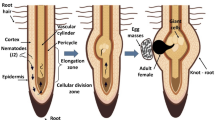Abstract
The host ranges ofCercospora piaropi andAcremonium zonatum, fungi native to Mexico and pathogens of waterhyacinth(Eichhornia crassipes), were evaluated using 31 plant species (some with several cultivars tested) representing 22 families of economic and ecological importance. The results showed that only waterlettuce(Pistia stratiotes), another abundant weed in Mexico, was infected byC. piaropi. The use of those pathogens in the biological control of waterhyacinth would not be expected to affect plants of economic and ecological importance in Mexico.
Similar content being viewed by others
References
Conway, K.E. and Freeman, T.E. (1977) Host specificity ofCercospora rodmanii. a potential biological control of waterhyacinth.Plant Dis. Rep. 61:262–266.
Dhingra Onkar, D. and Sinclair, J.B. (1994) Basic Plant Pathology Methods. CRC Press, Boca Raton, FL, USA.
Galbraith, J.C. (1987) The pathogenicity of an Australian isolateof Acremonium ronatum to waterhyacinth, and its relationship with the biological control agent,Neochetina eichhorniae.Aust. J. Agric. Res. 21:9–29.
Martínez Jiménez, M. and Charudattan, R. (1998) Survey and evaluation of Mexican native fungi for potential biocontrol of waterhyacinth.J. Aquat. Plant Manage. 36:145–148.
Novelo, A. (1996) Sistemática de la familia Pontedereaceae en México. [Systematics of Pontedereaceae in Mexico.] Ph.D. thesis, Universidad Nacional Autánoma de México, Mexico City.
Rintz, R.E. (1973) A zonal leaf spot of waterhyacinth caused byCephalosporium zonatum.Fla. Agric. Exp. Stn. J. Sci: 4494 11:41–44.
Rzedowski, J. (1994) Vegetación de México. [Vegetation of Mexico.] Ed. LIMUSA, Mexico City.
Secretaria de Agricultura Ganadería y Desarrollo Rural (1992) Dirección general de distritos de riego. Dirección de estadística y de estudios económicos. Catálogo de plantas de interés para la agricultura con sus nombres latinos y vulgares en español e inglés. [Catalogue of Plants of Agricultural Importance, with Latin and Common Naines in Spanish and English.] Mexico City.
Wapshere, A. (1974) A strategy for evaluating the safety of organisms for biological weed control.Ann. Appl. Biol. 77:201–211.
Author information
Authors and Affiliations
Corresponding author
Rights and permissions
About this article
Cite this article
Jiménez, M.M., López, E.G. Host range ofCercospora piaropi andAcremonium zonatum, potential fungal biocontrol agents for waterhyacinth in Mexico. Phytoparasitica 29, 175–177 (2001). https://doi.org/10.1007/BF02983963
Received:
Revised:
Issue Date:
DOI: https://doi.org/10.1007/BF02983963




